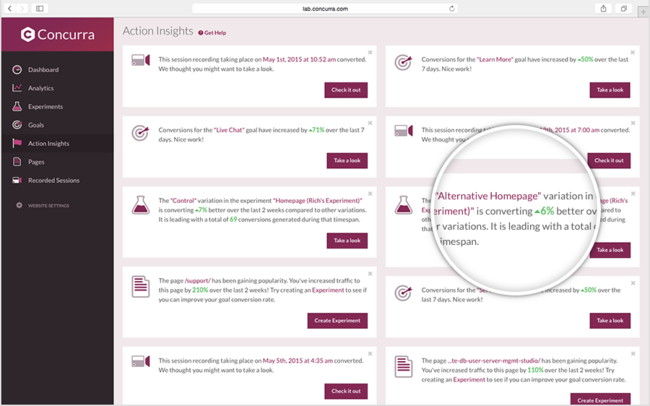Beginner’s Guide to A/B Testing
A/B Testing is employed to determine the best website layout, messaging, or both to be deployed with the sole purpose of improving conversion rates. The testing could be applied to search ads, website copy, sales emails and more. Here, we’re going to focus on A/B testing as it relates to websites.
First a word on terminology. When we say A/B testing, we mean split testing, or multivariate testing, almost interchangeably, but in reality most of the tests we perform are A/B variety. You can and should change lots of elements, but it is best to change those in one direction. More on that in a future post.
If planned and executed well, A/B Testing can instrumental in website optimization. If done poorly, it can be detrimental at best and downright harmful at worst.
Planning for your A/B test
The first step of implementing A/B tests is to determine what exactly you want to test and where. What page? What part of the page?
Concurra can help here with the pages and action insights sections. These help you identify pages.
You could also setup some multi-page conversion funnels to see where users are getting bogged down.
In you settle on an area for on-site analysis, factors to consider may include pieces on your website relating to sales, such as buttons, forms, related resources, and selling points. Consider placement – location on page, check the scroll map, how do your CTAs look relation to the true user fold?
Once you determine what to test, develop a list of all variables. For example, if you settle on testing call to action, the variables to be tested may include the exact text message sent out, the exact location of the call to action, and surrounding space or button color. This is a process, and therefore, it is common practice for Multivariate Test A/B to be conducted before making the final decision.
Before carrying out the test, you must clearly have an idea of what to expect; you must have the baseline results. You may carry out Split Testing by testing both option A and B against each other and determine which one gives an output which is desired or closer to what you expect. Make sure not to forget to configure your goals.
A/B Testing can REALLY improve your bottom line
Conducting A/B Testing successfully improves your bottom line by getting more out of the visitors you’re already getting to your website. No need to buy more traffic. You already got it. As a result, a business can determine marketing strategies which are progressive by gathering empirical data and doing control tests. This is a process of refinement that is never ending.
Website testing procedure
The best way to test a website is to stick to with the following guidelines to maximize your effectiveness:
- Identify a page or pages from your website that you want to optimize
- Determine at the website traffic so as to make a decision on which areas you may need to focus on
- Using Website Heatmap and recorded sessions, learn how users have been visiting your page and watch where they pause or hesitate
- You should identify areas on your website where visitors do not visit in spite of the fact that they are expected to -Equally, identify areas where they visit when they are not expected to
- Consider making radical changes to your website which includes removing links which distract visitors and dropping images that don’t add value to the marketing strategy, hence making it easy for your visitors reach where you want them to visit
- Remove the footer menu or top menu that may contain extra links that are unnecessary or distracting
- For your CTAs to stand out, you should try to create a significant color contrast or eye catching positions
- Carefully monitor results and in the process, you should compare Website Heatmap and replay session outputs
- A winning variation should only be picked once the system has suggested it or it has attained a statistical significance
- For consistency purposes, ensure that the process is regularly conducted
Devoting time for A/B Testing
It should be noted that A/B Testing is not an instant project but rather takes time and resources. Time taken to run the tests may range from a few days to several weeks, and this may be determined by the traffic flow and expected results. For accurate results, consider running the tests one at a time.
Insufficient time for a test may lead to skewed results because not many visitors would have visited the website and the test may not consider statistically accurate. On the contrary, running a test for too long (months) would equally give skewed results. This is because it may become difficult to control too many variables. Therefore, you need to be conscious of factors that may affect the overall performance. This is instrumental in ensuring that you can account for any anomalies when you are reviewing your results.
It is important to note that you may need to take a few weeks to get accurate results. It is advisable that you conduct just one or two tests at a time and that you allocate enough time for each of them and can keep up with them regularly.
